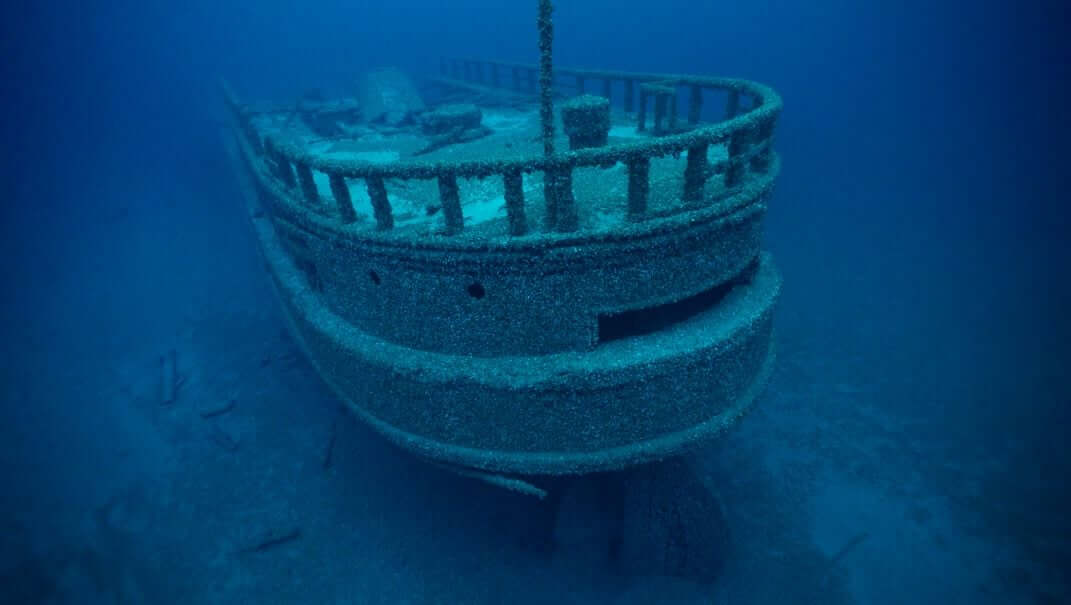
Filmmakers Stumble Upon 128 Year Old Shipwreck In Lake Huron
Yvonne Drebert and Zach Melnick set out to make a documentary about invasive quagga mussels in the Great Lakes. Along the way, they found the wreck of what is likely the steamship Africa, last seen on a stormy October night in 1895.
By: Sarah Kuta | Smithsonian
On a stormy night in October 1895, a cargo steamship called the Africa disappeared on Lake Huron. The ship’s location has been a mystery ever since.
Now, 128 years later, the Africa has been found. This summer, a pair of filmmakers working on a documentary about the devastating ecological damage caused by invasive mussels in the Great Lakes discovered the vessel’s final resting place, reports Canadian Geographic’s Christina Frangou.
Yvonne Drebert and Zach Melnick were boating with some friends in June when they stumbled upon the shipwreck. While working on their forthcoming film All Too Clear, they’d gotten a tip about a mysterious mound on the lake floor and decided to check it out.
When they reached the site of the purported mound—which was located off the west coast of Lake Huron’s Saugeen Peninsula in Ontario, Canada—they lowered their remotely operated underwater vehicle into the water. The robot’s camera captured a vessel covered in quagga mussels resting on the lake bed about 280 feet below the surface.

Initially, Drebert and Menick weren’t sure which shipwreck they’d discovered. Since the vessel was completely coated in mussels, they couldn’t see a name on the side. They then called in local maritime historian Patrick Folkes and marine archaeologist Scarlett Janusas.
After getting an archaeological license from Ontario, the group returned to the shipwreck to capture underwater video footage and take measurements. The wreck’s dimensions were consistent with the Africa, which was 148 feet long, 26 feet wide and 12.5 feet tall, per the Bayshore Broadcasting News Center’s Claire McCormack. They also found coal on the lake bed near the vessel, which aligned with the Africa’s story: The ship had been loaded with coal during its fateful journey.
The Africa departed Ashtabula, Ohio, on October 5, 1895. The vessel was towing a schooner named the Severn, and together they were carrying about 1,270 tons of coal. The ships made their way west on Lake Erie, then headed up the St. Clair River toward Lake Huron. Their final destination was Owen Sound, Ontario.
Two days later, as they neared the Saugeen Peninsula, a fierce snowstorm began. As the ships pitched and rolled on the waves, the Africa’s captain decided to release the Severn from its tow line.
The Severn struck a reef, but help arrived the next morning and rescued the schooner’s crew. The Africa, however, disappeared into the night. All 11 of the ship’s crew members perished.
“I have passed through some bad weather during my 35 years’ sailing, but that experience upon Lake Huron is as bad as any,” James Silversides, the Severn’s captain, told a local newspaper afterward, per Canadian Geographic.
The very same invasive creatures that are the focus of Drebert and Menick’s documentary likely helped them find the ship, reports Colin Butler for the Canadian Broadcasting Company. Quagga mussels filter the water around them while extracting microscopic particles for food. Without them, the water would have been murkier, and Drebert and Melnick may not have been able to see the vessel.
Overall, however, the mussels—about the size of a thumbnail—are doing more harm than good. Left unchecked, they will eventually destroy the shipwrecks in the Great Lakes (except those in Lake Superior, where so far the mussels haven’t been able to gain a foothold).
Marine archaeologists are now racing against time to document Great Lakes shipwrecks before it’s too late.

“The mussels burrow into wooden vessels, building upon themselves in layers so thick they will eventually crush walls and decks,” writes Todd Richmond of the Associated Press. “They also produce acid that can corrode steel and iron ships.”
Damage to shipwrecks aside, quagga mussels—and their invasive relatives, zebra mussels—have wreaked havoc on the Great Lakes’ underwater ecosystem. They outcompete and kill native mussels, and by encrusting the bottoms of the lakes, they’ve displaced native arthropods that burrow into the lakebed, according to the Centre for Invasive Species Research at the University of California at Riverside. Additionally, they have helped spread avian botulism, which has led to the deaths of tens of thousands of birds.
They also cause problems for humans. They clog pipes used by water treatment and power plants, and they cover beaches, docks, buoys and even boats in a thick layer. Their sharp shells can cut bare feet.
The mussels have “truly changed everything in the deep waters of the Great Lakes,” says Melnick, per CBS News’ Kerry Breen.
* * *
NEXT UP!
Historians Discover ‘Remarkably Intact’ Shipwreck, Undisturbed Beneath Lake Michigan For 142 Years
Nearly 150 years ago, the schooner Trinidad sank in Lake Michigan, roughly ten miles off the coast of Algoma, Wisconsin. Now, two maritime historians—Brendon Baillod and Bob Jaeck—have located the remains of the 140-foot-long ship, which they say is “remarkably intact.”
“We were stunned to see that not only was the deckhouse still on her, but it still had all the cabinets with all the dishes stacked in them and all the crew’s effects,” Baillod tells the New York Times’ Orlando Mayorquin. “It’s really like a ship in a bottle. It’s a time capsule.”
* * *
READ MORE: This Ancient Maya City Was Hidden In The Jungle For More Than 1,000 Years
Read more on Archaeology: Guanches: Ancient Mummies of The Canary Islands (Video)
Telegram: Stay connected and get the latest updates by following us on Telegram!
We’d love to hear from you! If you have a comment about this article or if you have a tip for a future Collective Spark Story please let us know below in the comment section.
